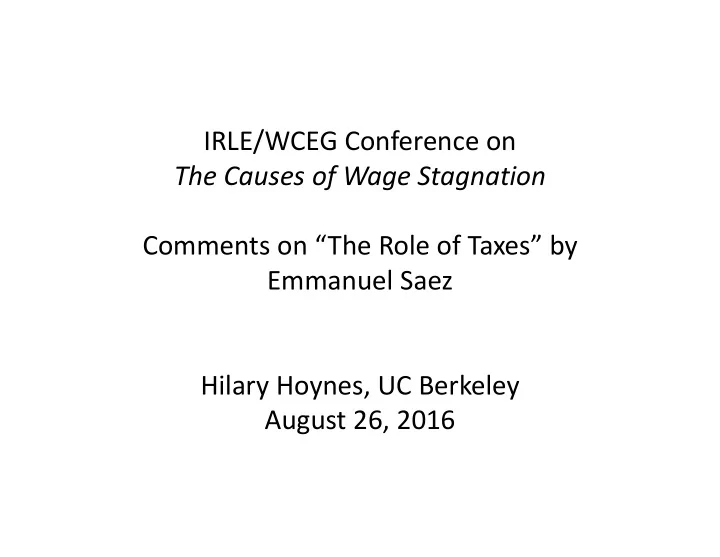

IRLE/WCEG Conference on The Causes of Wage Stagnation Comments on “The Role of Taxes” by Emmanuel Saez Hilary Hoynes, UC Berkeley August 26, 2016
My discussion 1. Short take: Define the problem, definitions 2. [A few] comments on Emmanuel’s presentation 3. Elaborating on the Role of Transfers (or more generally policies aimed at low income families)
What kind of stagnation are we thinking about? • Wages: the price of labor • Earnings = wage x hours, depends on the price of labor as well as labor supply • Family income • Before tax or after tax?
What role can taxes (and transfers) play? 1) Direct effects: taxes and transfers mechanically affect the post ‐ tax income distribution 2) Indirect effects: tax and transfers affect behavior and hence the pre ‐ tax distribution From Emmanuel’s slides
What role can taxes (and transfers) play? 1) Direct effects: taxes and transfers mechanically affect the post ‐ tax income distribution 2) Indirect effects I [partial equilibrium] : taxes and transfers affect behavior and hence the pre ‐ tax distribution 3) Indirect effects II [general equilibrium] : taxes and transfers affect behavior and hence may affect wages (and hence the pre ‐ tax distribution)
One of Emmanuel’s conclusions: Taxes and transfers have only modestly mitigated income stagnation at the bottom
• One of Emmanuel’s conclusions is: Taxes and transfers have only modestly mitigated income stagnation at the bottom
• This may be so for the bottom half of the distribution as a whole. But further down the distribution, the tax and transfer system has made more of a difference.
Pre ‐ Tax Post ‐ Tax The supplemental poverty measure improves on the official poverty measure by (1) expanding resources to include most tax and transfer, (2) updating the poverty threshold and (3) allowing for geographic variation in the poverty threshold Source: Wimer et al (2016).
What is included in the resource measure is important. Source: Tabulations based on the supplemental poverty measure and Short (2015).
My discussion 1. Short take: Define the problem, definitions 2. [A few] comments on Emmanuel’s presentation 3. Elaborating on the Role of Transfers (or more generally policies aimed at low income families)
Cash In Kind Public Assistance (Means tested) AFDC/TANF SNAP SSI WIC EITC School Meals Child Tax Credit Medicaid (refundable) Housing programs LIHEAP Social Insurance Social Security Medicare SSDI Unemployment Ins Workers Comp
Major change in tax and transfers for the low income population • Transition from out of work (welfare) to in work benefits. – Welfare reform – The expansion of the EITC
With TANF, welfare is all but disappeared Source: Bitler and Hoynes, The Hamilton Project (2016).
The EITC is the main program to address wage and earnings stagnation In 2013 among tax filers with children: 44% received the EITC $3,062 average credit Source: Updated figure from Bitler and Hoynes (2010).
How is the safety net expected to affect 2015 behavior and wages? How has this changed over time?
2015 I’m going to ignore TANF and housing
1992: pre welfare reform and expansion of the EITC Much more out of work assistance Much higher work disincentives
What does the EITC do for wage and earnings stagnation? • Direct effect: increase post ‐ tax and transfer income (due to credit amount) • Indirect effect I partial equilibrium: increase employment (at least for unmarried recipients) and thus increase pre ‐ T&T income • Indirect effect II general equilibrium: increase in labor supply puts downward pressure on wages – Less is known about this compared to large literature on the partial equilibrium effects – Rothstein (2010) simulates effects using demand and supply elasticities and finds substantial reductions in pre ‐ tax wages due to federal EITC; overstating transfers to workers by one ‐ third – Includes negative spillovers on ineligible low skilled workers (childless)
Single Moms Source: Nichols and Rothstein “The Earned Income Tax Credit,” forthcoming in Means Tested Transfer Program s in the U.S. Volum e 2 , Robert Moffitt ed.
Event Study Estimates of the Effects of OBRA1993 on Employment The 1993 expansion led to: 6.1 pp increase in the employment rate [Ext Marg Elas=0.36] Source: Hoynes and Patel (2015). “Effective Policy for Reducing Inequality? The Earned Income Tax Credit and the Distribution of Income”
Event Study Estimates of the Effects of OBRA1993 on Employment Larger effects for women with 2+ children: 8.9 pp increase in emp. Source: Hoynes and Patel “Effective Policy for Reducing Inequality? The Earned Income Tax Credit and the Distribution of Income”
Estimating the effect of the EITC on the distribution of income Effects of the 1993 expansion on the share of families above income ‐ to ‐ poverty levels. Concentrated between 75% and 200% of poverty Source: Hoynes and Patel (2015). “Effective Policy for Reducing Inequality? The Earned Income Tax Credit and the Distribution of Income”
Static versus Dynamic Calculations of Anti-Poverty Effects Sim ulated num ber of children raised above incom e-to-poverty cutoffs Ignoring the behavioral response leads to an underestimate of the anti ‐ poverty effects by 50 percent Source: Hoynes and Patel (2015). “Effective Policy for Reducing Inequality? The Earned Income Tax Credit and the Distribution of Income”
Thoughts for the discussion • We need more work on general equilibrium effects • Are there limits to loading benefits onto in ‐ work programs? • To what extent will the increases in minimum wages mitigate the GE effects on wages? • Convert Child Tax Credit to universal child benefit (Canada) • Is UBI the answer? (probably not)
BONUS SLIDES
MEN EPI, State of Working America.
WOMEN EPI, State of Working America.
Declining m ale labor force participation rate MEN WOMEN Economic Report of the President, 2015.
The result: Little gain in fam ily incom es below m edian
Recommend
More recommend